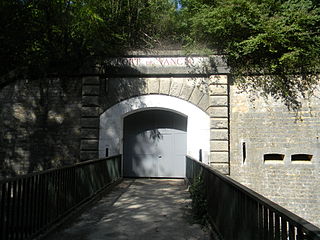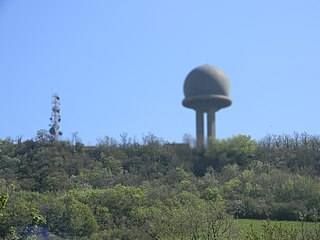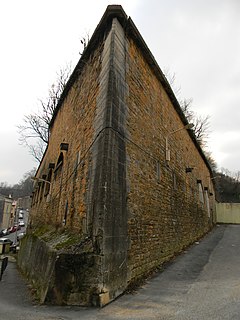
Bron is a commune in the Metropolis of Lyon in Auvergne-Rhône-Alpes region in eastern France.

The Lyon tramway comprises seven lines, six lines operated by TCL and one by Rhônexpress in the city of Lyon in Auvergne-Rhône-Alpes, France. The original tramway network in Lyon was developed in 1879, and the modern network was built in 2001.

Ouvrage Sapey is a work of the Maginot Line's Alpine extension, the Alpine Line, also known as the Little Maginot Line. The ouvrage consists of one entry block, three artillery blocks and one observation block two kilometers west of Modane. The ouvrage was built beneath the older Fort du Sapey. The new work cost 12.8 million francs.

Ouvrage Janus is a work of the Maginot Line's Alpine extension, the Alpine Line, located to the east of Briançon on near the Col de Montgenèvre. The ouvrage consists of one entry block, two infantry blocks, two artillery blocks, two observation blocks and one combination block at an altitude of 2,540 metres (8,330 ft), the second highest fortification on the Alps in 1940. Built on the site of the old Fort Janus, it retained the old fort's 95mm naval guns and added two 75mm guns

Ouvrage Mont Agel is a work of the Maginot Line's Alpine extension, the Alpine Line, also called the Little Maginot Line. The 1930s ouvrage was built in and around the earlier mountaintop Fortress of Mont Agel. The ouvrage forms a backup to the main curtain of Alpine Line forts, and was not initially planned as part of the Alpine Line proper. Its intended function was primarily to provide heavy, long-range artillery support from a location well to the rear of the line. However, the planned 145mm heavy guns were never installed. Its site on Mont Agel, at an altitude of 1,118 metres (3,668 ft), is the highest point in the vicinity of Nice and Menton and commands the entire coastline, as well as the approaches from Sospel to the north. The site is now occupied by Base Aérienne 943 of the French Air Force and functions as an air defense control station.

The Séré de Rivières system was named after Raymond Adolphe Séré de Rivières, its originator. The system was an ensemble of fortifications built from 1874 along the frontiers and coasts of France. The fortresses were obsolescent by 1914 but were used during the First World War.

The fortified region of Belfort(place fortifiée de Belfort) formed the first line of defense in the Séré de Rivières system of fortifications in the Belfort Gap. Located in northeastern France between Épinal and Besançon, the primary line was built in the late 19th century to deal with advances in artillery that had made older defensive systems obsolete.

Fort de Villey-le-Sec, also known as Fort Trévise, is a fortification of the 19th century, built as part of the Séré de Rivières system of fortifications in Villey-le-Sec, France, one of the defenses of Toul. It is a unique example for its time of a defensive enclosure around a village. Conceived after the defeat of the Franco-Prussian War of 1870-71, the fort was located away from the main combat zone of World War I and has remained almost intact. The fort's preservation association has been at work since 1961 to restore and interpret the site. It has been included in the Inventory of Historic Sites and has been designated as a preserved natural area.

The Fort de Liouville, also known as Fort Stengel, located between the communes of Saint-Agnant-sous-les-Côtes and Saint-Julien-sous-les-Côtes, near the town of Commercy in the Meuse departement of France, is one of the forts built at the end of the 19th century to defend the valley of the Meuse. The fort was located on what was then the French frontier facing the German-occupied province of Lorraine. The Fort de Liouville was located between the Fort de Gironville and the Camp des Romains.

The Fort du Replaton is a fortification of the Séré de Rivières system in Modane, France. The fort was built to provide artillery cover for the French end of the Fréjus Rail Tunnel 800 metres (2,600 ft) away horizontally. It is connected to Modane by an aerial tram, which continues on from Replaton to the Fort du Sapey on a much higher eminence.

Fort du Mont Bart is located to the south of Montbéliard, France. It was built between November 1874 and July 1877 as part of the Séré de Rivières system of fortifications. The fort overlooks the valleys of the Doubs and the Allan at an elevation of 497 metres (1,631 ft), standing to the south and rear of the fortified region of Belfort and in control of the road to Besançon. The fort was intended to augment the Belfort fortifications and to prevent an enemy from bypassing them. The most striking feature of the Fort du Mont Bart is its "interior street", originally constructed in the open air as a sunken court, then covered before World War I with reinforced concrete.

The Fort du Bruissin is a fort in Francheville, France, near the city of Lyon. Built between 1878 and 1881, the fort is part of the Séré de Rivières system of fortifications built in the late 19th century. It has been rehabilitated as a contemporary artists' community. The Fort en Jazz festival is held there each year.

The Fort de Plappeville, or Feste Alvensleben, is a military fortification located to the northwest of Metz in the commune of Plappeville. As part of the first ring of the fortifications of Metz, it is an early example of a Séré de Rivières system fort. While it did not see action during World War I, it was the scene of heavy fighting between American forces and German defenders at the end of the Battle of Metz, in 1944. After Second World War it became a training center for the French Air Force. Fort 'Alvensleben' has been abandoned since 1995.

The Fort de Maulde, also known as Fort de Beurnonville and the Ensemble de Maulde, is located to the south of Maulde, France. It is part of the Fortified Sector of the Escaut, an extension of the Maginot Line. The Séré de Rivières system fort was built 1881–1884. In 1936–1937 the old fort, commanding high ground behind Maulde, was altered for more modern fortifications. It was evacuated by its garrison in 1940 during the Battle of France as part of the French retreat from the border with Belgium.

The Fort de Bicêtre is a military structure built between 1841 and 1845 during the reign of Louis-Philippe during a time of tension between France and England, in the Paris suburb of Kremlin-Bicêtre. The fort is part of the Thiers Wall fortifications of Paris, built under a program of defensive works initiated by Adolphe Thiers. The fort served as a prison for those involved in the French coup of 1851.

The Fort de Vancia is a former military installation built between 1872 and 1878 in the municipalities of Sathonay-Village and Rillieux-la-Pape, north of Lyon. It is part of the second belt Lyon and more generally the system Sere de Rivieres. This belt of forts included the forts of Bron, Vancia itself, Feyzin and Mont Verdun.

The Fort Feyzin is a fort built between 1875 and 1877 in Feyzin. It is one of the forts of the second belt of forts around Lyon and more generally the Séré de Rivières fort system. This belt of forts included the forts of Bron, Vancia, Feyzin and Mont Verdun. It currently houses a riding stable managed by the UCPA on behalf of the city of Feyzin.

Fort Mont Verdun is the biggest highlight of the second belt of Forts around Lyon and is the only one considered to be a mountain fort. It rests at 630 meters altitude, dominating Lyon, Limonest, the lower Azergues valley and the Saône valley. It was covered by a low battery and four other associated batteries: Mont Thou, Les Carrières, Narcel and La Freta. It is now occupied by the Airbase 942 Lyon-Mont Verdun.

Fort de Loyasse is a fort built between 1836 and 1840. It is currently in the 9th arrondissement of Lyon and is part of the first belt of forts protecting Lyon.

The ceintures de Lyon were a series of fortifications built between 1830 and 1890 around the city of Lyon, France to protect the city from foreign invasion.
























